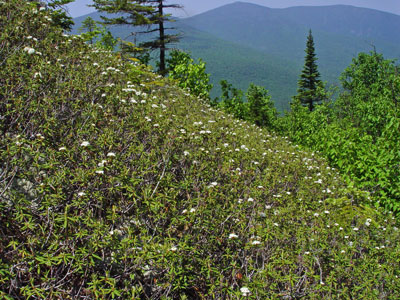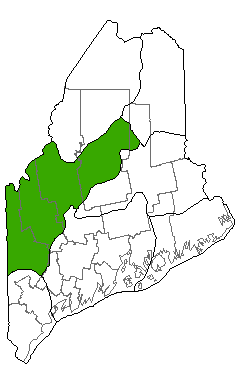DACF Home → Bureaus & Programs → Maine Natural Areas Program → Communities, Plants, and Animals → Natural Community Fact Sheets → Subalpine Hanging Bog
Printer Friendly Fact Sheet - 1.1 MB pdf (Get a free copy of Adobe Acrobat Reader)
Subalpine Hanging Bog
Scientific Name: Heath - Lichen Subalpine Slope Bog; State Rank: S1

- Community Description
- Soil and Site Characteristics
- Diagnostics
- Similar Types
- Conservation, Wildlife and Management Considerations
- Distribution
- Characteristic Plants
- Associated Rare Plants
- Associated Rare Animals
- Examples on Conservation Lands You Can Visit
Community Description: A dwarf shrub bog tilted on its side, this community consists of typical heath bog shrubs growing on a dense peat moss carpet over rocky slopes. Typical species include Labrador tea, sheep laurel, and rhodora. Stunted trees, such as northern white cedar, heart-leaved paper birch, or black spruce, may be scattered among the shrubs, but form <25% cover overall. Herbs are sparse, but may include boreal species such as northern comandra. Back to top.
Soil and Site Characteristics: Known sites are documented from nearly vertical talus slides in at elevations >2000’, but this type may occur in other subalpine settings. Back to top.
Diagnostics: Heath shrubs (sheep laurel, Labrador tea, leatherleaf) are dominant on a peat moss substrate, but this type is not a peatland. Vegetation occurs as a thin layer over bedrock, talus, or scree in a subalpine setting. Back to top.
Similar Types: Dwarf Shrub Bog vegetation is compositionally similar, but occurs in a peatland setting. Maritime Slope Bogs are floristically almost identical but occur in a different setting. Alpine Bogs occur in basins rather than on slopes and typically have higher herbaceous cover. Cold - Air Talus Slopes have less vegetation cover (particularly of peat moss) and occur at lower elevations; but the two types may grade into one another. Back to top.
Conservation, Wildlife and Management Considerations: The few documented sites are off trail. Access is difficult to dangerous, and foot traffic could damage the vegetation, which grows densely enough that one cannot avoid it by picking one's way over rocks, as can be done with some other alpine/subalpine vegetation types. Other subalpine settings where this might occur would have similar access constraints. Because alpine vegetation grows slowly under harsh conditions, recovery from damage can take a long time. Back to top.
Distribution: Montane western Maine, extending west into New Hampsire and possibly Vermont and upstate New York (New England - Adirondack Province); likely extends northeasterly to the Gaspé peninsula. Landscape Pattern: Small Patch. Back to top.


Characteristic Plants: These plants are frequently found in this community type. Those with an asterisk are often diagnostic of this community.
- Sapling/shrub
- Heart-leaved paper birch
- Larch
- Mountain alder
- Black spruce
- Dwarf Shrub
- Alpine bilberry
- Labrador tea*
- Leatherleaf
- Rhodora
- Sheep laurel*
- Squashberry
- Herb
- Bunchberry
- Goldthread
- Northern comandra
- Bryoid
- Reindeer lichen*
- Sphagnum mosses*
There are no documented rare animals associated with this natural community.
Examples on Conservation Lands You Can Visit
| Example | County |
|---|---|
| Crocker Mountain, Appalachian Trail | Franklin Co. |